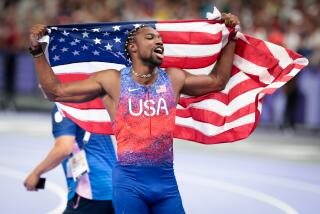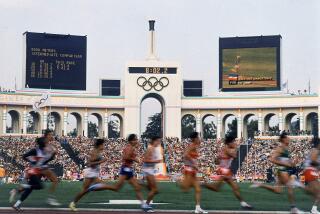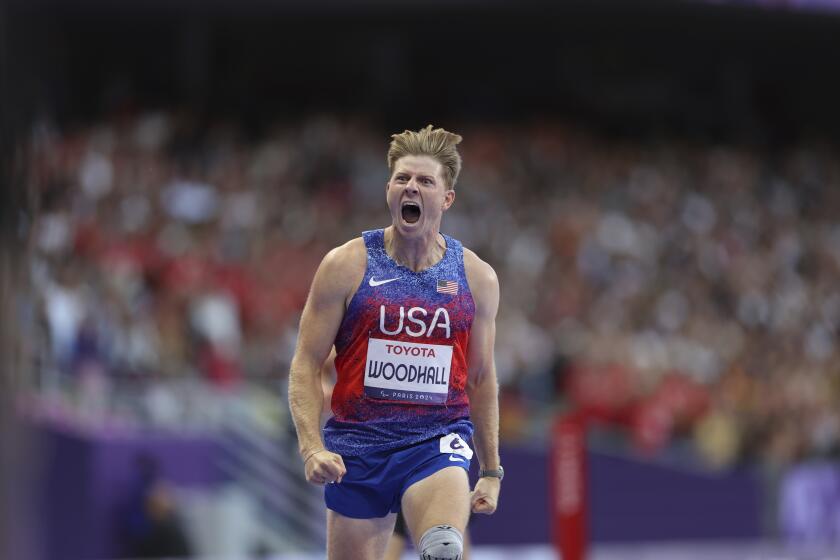Down Memory Lane on Coliseum Track
On the site where Jesse Owens and Paavo Nurmi ran, Carl Lewis and Charlie Dumas jumped and Edwin Moses and Babe Didriksen hurdled, construction workers arrived Monday morning to remove the track in the only stadium ever to serve as the stage for two Summer Olympics.
The latest Coliseum track, a synthetic surface laid for the 1984 Games, will be put in storage until the powers that be determine its fate. Without it, only memories remain of more track and field history than has occurred in any other stadium in the United States.
It would be virtually impossible for anyone living today to recall all of the outstanding moments. There were too many over too many years between 1923 and 1993.
For that reason, several Southern Californians who are members of an almost extinct breed of track and field enthusiasts were contacted--men such as Dwayne Esper, D.H. Potts, George Ambrose, Scott Davis, Bob Seaman and Bruce Tenen, who vividly remember great events they witnessed in the Coliseum and are nostalgic even for those they did not.
The first time he went to the Coliseum, Ambrose was 8 years old. He saw William Carr beat Ben Eastman and set a world record in the 400-meter final in the 1932 Games. On Potts’ first visit in 1941, California’s two-mile relay team set a world record in the first Coliseum Relays. On Seamen’s first visit in 1952, he ran the mile in the State high school meet.
“It was frightening, to be on the track where all those world records had been set,” Seaman said.
During a stretch of almost four decades, it seemed impossible to attend a meet in the Coliseum without seeing a world record. Sixty-two were set there, five by shotputter Parry O’Brien. It is a commentary, not only on track and field but on our society, that only five were set by women, none after ’32.
The sport, however, has been progressive in other ways. More than two decades before Jackie Robinson was credited for breaking baseball’s color barrier, black track and field athletes competed in the Coliseum.
Besides two Olympics, there were four Olympic trials, four NCAA meets and the 1964 U.S.-USSR dual meet held in the Coliseum. Its first meet of international significance, in 1925, drew 31,554 to see Nurmi. The names of other athletes who have participated there read like a roll call for track and field’s hall of fame.
But the anonymous were often equally sublime to watch. Hardly anyone speaks of his fondest memories without mentioning the high school boys’ eight-man mile relay that was featured in the annual Coliseum Relays.
On Monday, when the front loaders arrived to roll up the track, an era ended. For all practical purposes, though, it ended with the closing ceremony of the ’84 Games. Because of declining interest in the sport in the United States, there has been only one international meet since in the Coliseum, rendering the track dispensable when the management company, SMG, began a renovation project to accommodate football, concerts, soccer and other events.
The project manager, Don Webb, said the track could be reinstalled if necessary, perhaps for a future Summer Olympics. That, however, is not likely to come for another two or three decades.
“The only stadium to hold two Summer Olympics now has no track,” Davis said. “It’s sad.”
Perhaps also inevitable.
“There’s no point in wasting 100,000 seats on a track meet,” Potts said. “The New York Athletic Club used to have the greatest track in the world, and it’s gone. Everything ends.”
But the memories from seven decades of track and field in the Coliseum linger:
CHARLES PADDOCK VS. CHARLES BORAH
May 15, 1926
Of the 100-yard duel between the 1920 Olympic sprint champion, Charles Paddock, and Charles Borah in the South Pacific AAU meet, Maxwell Stiles of the Los Angeles Examiner wrote: “There was the wildest confusion as Borah, leading by more than two feet at 98 yards, was caught by Paddock’s savage finish. They broke the tape together and Borah was raised on the shoulders of a Trojan serpentine and carried off the field as the conqueror of the mighty Paddock.”
But the judges ruled that Paddock was the conqueror, gaining the edge with his “savage finish,” a trademark flying close of 12 to 15 feet.
When their decision was announced, the crowd protested with chants of “Robber! Robber!” But Potts said photos of the finish vindicate the judges. Both Paddock and Borah were credited with world-record equaling times of 9.6 seconds, although three of four official watches caught Paddock in 9.5.
X SUMMER OLYMPICS
July 30-Aug. 14, 1932
In 29 track and field events, 14 world and eight Olympic records were broken.
Among the more memorable moments were Eddie Tolan’s victories in the 100 and 200, the latter of which is still disputed because bronze medalist Ralph Metcalfe was forced to dig his starting holes three or four feet behind where they should have been; William Carr’s time of 46.2 in the 400 meters that ushered in a new era for quarter-milers and Finn Lauri Lehtinen’s controversial lane-changing tactics in the stretch to win the 5,000 ahead of Ralph Hill.
But the most spectacular performances in the ’32 Games belonged to Mildred (Babe) Didriksen. She won two of the six women’s events and set world records in three, the 80-meter hurdles, the javelin throw and the high jump. She settled for a silver medal in the high jump when judges rules that she illegally dived over the bar in a jump-off for first place with Jean Shiley.
“Babe Breaks Records Easier Than Dishes,” read one Times headline over an article written by Grantland Rice.
JESSE OWENS VS. USC
June 15, 1935
Twenty days after he had broken three world records and tied another in one day of the Western Conference meet at Ann Arbor, Mich., Jesse Owens came West to compete in a dual meet for Ohio State against USC. The Trojans won with nine victories to the Buckeyes’ six, four of which were by Owens--in the 100 yards, the 220, the 220 high hurdles and the long jump.
Some among the crowd of 40,000 reportedly were disappointed because Owens did not set a world record, but Times sports editor Bill Henry was not among them.
“He won four first places from the greatest track team in the country, and he won them so easily that it was hard to believe what you had just seen,” Henry wrote.
Owens’ 20.7 in the 220 and 25 feet 5 1/2 in the long jump were Coliseum records.
ASCENT OF THE HEAVENLY TWINS
May 29, 1937
In the era of bamboo poles, USC teammates Bill Sefton and Earle Meadows, known as the Heavenly Twins, had set world records in 1937 before the Pacific Coast Conference pole vault competition. On that day, they both did it again, clearing 14-11.
“They might have become the first to clear the 15-foot mark that day,” Esper said, “but the standard couldn’t be raised higher than 14-11.”
THREE FASTEST MILE RELAYS
June 17, 1941
The Cal, USC and Occidental mile relay teams broke the world record in a triangular meet, but, even with its fast time, Occidental never was in the race. Cal had a substantial lead at 880 yards, but USC’s Cliff Bourland made up much of the difference on the third leg and Hubie Kerns all but passed Cal’s Grover Klemmer on the anchor. Both teams were timed in 3:09.4, but Cal was awarded the victory in a photo finish.
FIRST SEVEN-FOOT HIGH JUMP
June 29, 1956
In the 15 years after Lester Steers cleared 6-11 in a Pacific Coast Conference-Big Ten dual meet in the Coliseum, no one had been able to go that extra inch until Charlie Dumas did it in the U.S. Olympic trials. It was worth the price of admission, especially for Dumas. He had to buy a ticket to get into the meet because his coach, Herschel Smith, did not arrive with the athlete’s pass until after the competition had begun.
Among other milestones in the Coliseum, Jim Bailey ran the first sub-four-minute mile on U.S. soil in a stunning upset over John Landy in 1956, Parry O’Brien had the first 60-foot shotput in ‘54, and Al Oerter had the first 200-foot discus throw in ’62.
FABULOUS FLEA’S FABULOUS RACE
July 25, 1964
At the height of the Cold War, the United States and USSR met in the latest in a series of dual meets that had begun in 1958. The Soviets had won the first five, so there was no reason to believe the sixth would be different.
One event they were expected to dominate was the men’s 10,000 meters. Neither U.S. runner had come within 42 seconds of the two Soviets’ best times. Indeed, one of the U.S. runners was a 5-foot-6, 118-pound 18-year-old high school senior from Spokane, Wash., who had run only one 10,000-meter race.
Gerry Lindgren, wrote Times sports editor Paul Zimmerman, was a “high school boy sent into a man’s event.” But Lindgren, known as “the Fabulous Flea,” met the challenge, moving into the lead with 2 1/2 miles remaining and winning easily. He beat Leonid Ivanov by 150 yards and almost lapped Nikolay Dutov.
When it became apparent that Lindgren would win, “pandemonium” broke out among the crowd of 50,159, according to The Times.
“The crowd would have come out of the stands after the race and carried him around the track if it could have,” said one observer, Bruce Tenen. Another, Esper, said, “Nationalism reared its ugly head.”
The momentum was sustained through the next day, when the United States beat the Soviets, 187-156.
XXIII SUMMER OLYMPICS
July 28-Aug. 12, 1984
It was time to celebrate again for the United States, which won gold medals in 16 of 41 track and field events.
Carl Lewis won four of them in the same events, the 100 and 200 meters, the long jump and the 400-meter relay, in which Owens had won his 48 years before at Berlin. Edwin Moses extended his winning streak in the 400-meter intermediate hurdles to 90 finals in seven years. Joan Benoit won the first women’s marathon in a race that is equally remembered for Gabriele Andersen-Scheiss’ lurching, staggering ordeal to reach the finish line. She made it, in 37th place, without falling.
Falling was the fate of Mary Decker Slaney, who collapsed into the infield after her legs had become tangled with Zola Budd’s in the 3,000 meters. Trivia question: Who won? Romania’s Maricica Puica.
More to Read
Go beyond the scoreboard
Get the latest on L.A.'s teams in the daily Sports Report newsletter.
You may occasionally receive promotional content from the Los Angeles Times.







